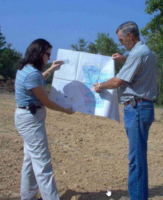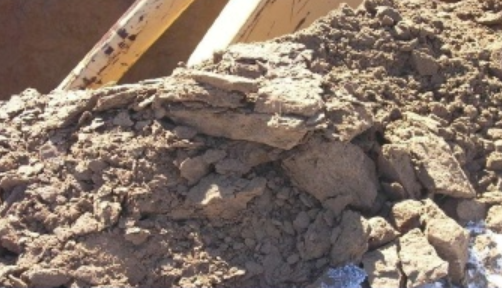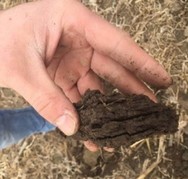|
 How to request an Onsite Wastewater System (Septic System) Inspection

The Onsite Wastewater Program performs several types of inspections related to septic systems. Requests for inspection come to the Department as part of a septic system permitting approval, in response to a submitted concern or complaint, or for other investigative purpose. A request for inspection can be made utilizing the following options:
|
Hazardous Waste Rule
Effective Nov. 3, 2020

ADEQ’s Hazardous Waste Rule became effective on Nov. 3, 2020, and is now published in the Arizona Administrative Register.
This rule incorporates EPA regulations, such as:
- Revisions to the Definition of Solid Waste (2008)
- Definition of Solid Waste (2015)
- Safe Management of Recalled Airbags (2018)
- Management Standards for Hazardous Waste Pharmaceuticals and Amendment to the P075 Listing for Nicotine (2019)
- Increasing Recycling: Adding Aerosol Cans to the Universal Waste Regulations (2019)
For more information about this rulemaking, please visit ADEQ's Rulemaking page.
|
Septic System Documentation
The Department has recently received some inquiries about what documentation is required to be submitted for final approval of the septic system. For your typical septic system (conventional), the Department requires the Request for Discharge Authorization form and an as-built site plan if the original site plan does not accurately reflect the installation. More advanced systems (alternative), beyond a septic tank and gravity disposal, require additional documents for the final approval. These include, but are not limited to, systems with pumps, aerators, disinfection, or special filters. These types of systems require the as-built plan and Request for Discharge Authorization form in addition to the following:
- Final list of equipment and materials
- Final operation and maintenance manual
- Certificate of Completion signed by the person responsible for assuring the installation conforms to the approved plans
- The name of the installation contractor and Registrar of Contractor’s license number
- Other documents stipulated on the Construction Authorization
- A service contract for permits issued under the type 4.04 and 4.08-4.22 General Permits.
|
Our Team is Here to Help You!
The Water & Waste Division of the Maricopa County Environmental Services Department, has a professional team of engineers, plan reviewers, environmental health specialists field inspectors, administrative assistants and experienced leadership that is committed to provide you with the best customer service experience.
|
If you have any questions or need any assistance, feel free to contact us:
Eric Matson, Water & Waste Management Division Manager Eric.Matson@maricopa.gov
(602) 506-0371
Thomas Hanson, Onsite Wastewater Managing Supervisor Thomas.Hanson@maricopa.gov
(602) 506-0372
Ashley Chatfield, Environmental Specialist Supervisor, Onsite Wastewater
Ashley.Chatfield@maricopa.gov
(602) 526-6143
Brian Knisley, Environmental Specialist Supervisor, Onsite Wastewater Brian.Knisley@maricopa.gov
(602) 228-0964
Kenyatta Mangar, Drinking Water Program Supervisor
Kenyata.Mangar@maricopa.gov
(602) 506-6935
Greg Epperson, Aquatic Health & Safety Managing Supervisor
Gregory.Epperson@maricopa.gov
(602) 506-0462
Joel Peterson, Water/Wastewater Treatment Program Manager
Joel.Peterson@maricopa.gov
(602) 506-6670
|
Customer Service Options

As a reminder, all of our customer service lobbies remain closed to ensure the health and safety of our customers and staff during the COVID-19 pandemic.
Please visit our website ESD.Maricopa.gov and click on our Virtual Permit Counter for links to our applications, forms and assistance with online plan submittal.
|
Materials and Manufactured System Components
When planning, designing, or installing a septic system, manufactured components are a must. These include septic tanks, pipe, chambers, distribution boxes, pumps, and much more. The use of these manufactured components requires the design, installation, and operation of the components to meet the manufacturer’s specifications. In addition to the manufacturer’s requirements, the Arizona Administrative Code, Title 18, Chapter 9, has requirements and specifications for design, installation and operation of septic systems and their components. In the event that the manufacturer’s specifications do not meet the requirements of the Arizona Administrative Code in which voids the product’s warranty, an applicant should contact the Department to determine what options are available.

In some situations, an applicant may be able to apply for a variance justifying the use of the manufacturer’s specifications. For more information, see Arizona Administrative Code R18-9-A312(F).
In an effort to assist applicants in this respect, the Department has recently posted on our website chamber and engineered aggregate module disposal technology sizing recommendations provided by the manufacturer. In addition, the Department has updated the septic system design worksheets to reflect the manufacturers’ recommendations. These new forms can be found at Design Guides | Maricopa County, AZ.
|
|
|
Day in the Life of a Pool Inspector

What happens during one of our department’s inspection to a public and/or semi public pool in Maricopa County?
Environmental Health Specialist Alisa Misevich takes us to one of her inspections and shows us what Environmental Services Department does to ensure public safety and minimize aquatic water-related health risks.
Click on link below to watch video on ESD's YouTube channel:
|
Septic System Design Variances

The Arizona Administrative Code R18-9-A312(G) allows for alternative design, setback, installation, or operational features when permitting an onsite wastewater treatment facility when the proposal meets specific criteria, justified with supporting documentation, and achieves equal or better performance. In other words, it allows for a variance to the regulations under specific circumstances.
A variance to the regulation may be approved with proper justification and design for:
- Conventional septic systems with pumps that lead up to a distribution box to then discharge subsurface by gravity.
- Septic system designs that propose one type of treatment/disposal technology for the primary system and a different type for the reserve system.
A variance to the regulation may not be approved by this Department for:
Designs or system configurations that do not meet the requirements of the Arizona Administrative Code, the ADEQ proprietary product approval, and the manufacturer’s requirements.
|
Maricopa County Planning and Development Environmental Compliance Checks

For anyone that has recently developed property in unincorporated Maricopa County, you may have noticed a process change. When proposing to develop property, the typical application process with Planning and Development involves the review of the proposal by multiple county agencies to ensure efficient and compliant development of the property. Other agencies can include Department of Transportation, Flood Control, and Environmental Services. To reduce submittal requirements and increase efficiency, a number of building permit reviews previously conducted by the Environmental Services Department and others have been centralized at Planning and Development. This includes checking stormwater and onsite wastewater compliance with the current proposal.
|
ADEQ Clarification for Moist Consistency in Soils Classifications

For those that perform site and soils evaluations in Arizona for onsite wastewater treatment facilities, please see the below guidance provided by ADEQ for completion of the ADEQ Uniform Site Investigation Report.
Clarification for consistent implementation of AAC R18-9-A309(B)(1)(a)
Purpose of this policy
In recent years, ADEQ has received a number of questions regarding the terms (a) “consistence” as listed in Arizona Administrative Code (AAC) Title 18 Chapter 9 at R18-9-A310 (E)(3)(a) and R18-9-A310 (F)(3)(f)(i) and (b) “Dry consistency” and “Moist Consistency” as listed in the Uniform Site Investigation Report Form. In an effort to ensure consistent implementation of AAC R18-9-A309 (B)(1)(a) across all counties, ADEQ is issuing this policy defining the terms consistence, dry, moist, dry consistency and moist consistency. In addition, ADEQ is listing the minimum data required by all applicants when seeking an NOI to discharge under a Type 4 General Permit with regards to consistence. ADEQ hopes this memo will clarify the minimum data required as it relates to consistence as part of any Type 4 General permit. Improperly interpreting the terms has the potential for a poor engineering design and can reduce the onsite wastewater treatment facility’s ability to adequately treat and potentially result in an adverse impact on the environment.
Definitions
- Consistence: Soil consistence is defined as the resistance of a material to deformation or rupture or expressed in degree of cohesion and adhesion (Gustafson et al., 2016; US EPA, 1980).
- Dry: Dry is defined in ASTM D5921 Table 11 Classes of Soil Water as “Very little visual or tactile change between field observation and after air-dried samples” (ASTM, 1996).
- Moist: Moist is defined in ASTM D5921 Table 11 Classes of Soil Water as “Visual or tactile change between field observation and after air drying” (ASTM, 1996).
- Wet: Wet is defined in ASTM D5921 Table 11 Classes of Soil Water as “Water films evident, or free water” (ASTM, 1996).
- Dry consistency: Consistence described for dry state.
- Moist consistency: Consistence described for moist state.
|

Both AAC R18-9-A310 (E) and AAC R18-9-A310 (F) require applicants to submit consistence (soil) under AAC R18-9-A310 (E)(3)(a) and AAC R18-9-A310(F)(3)(f)(i) respectively. Additionally, moist consistence is required for determining the Soil Absorption Rate (SAR) using the table listed in R18-9-A312 (D)(2)(b). Consistence is not explicitly stated as required information if the applicant is using the seepage pit performance test listed in AAC R18-9-A310 (G).
AAC R18-9-A310 (E) lists Standard Practice ASTM D5921 - 96 (Reapproved 2003) which describes a procedure for classifying soil by field observable characteristics within the USDA SCS classification system based on visual examination and manual tests. Section 6.1 of ASTM 5921 states the soil should be evaluated in the moist condition and Table 11 defines the term moist.
Conclusion
Percolation tests do not always measure hydraulic conductivity accurately (can vary by 90% or more when conducted in the same soils) and US EPA recommends combining percolation test data with other soil data to estimate hydraulic conductivity (US EPA, 1980). Furthermore, supplementing soil percolation tests with soil morphologic descriptions such as consistence are better predictors of soils hydraulic capacity than percolation tests (US EPA, 2002). Section 1.1 and Section 6.1 of ASTM D5921 describes the normal operating state of the septic system is moist (ASTM, 1996). In addition, Table 3.4 (Gustafson et al., 2016) only lists loading rates for very friable and friable consistence and loose non-cemented soils and states that soil’s moisture content should be similar to that expected in the soil surrounding a soil treatment system (Gustafson et al., 2016). It only lists moist consistence classes in addition to explicitly stating that only moist samples be used. Furthermore, it states that consistence will provide the designer with information necessary to determine the correct soil loading rate (Gustafson et al., 2016). Therefore, the moist consistency column must be filled out as that information is crucial for the design of a septic system unless using the seepage pit performance test listed in AAC R18-9-A310 (G).
References
AAC. (2019). Title 18. Environmental Quality. Chapter 9. Department of Environmental quality - Water pollution control.
ASTM. (1996). Standard practice for subsurface site characterization of test pits for on-site septic systems.
Gustafson, D., Haig, N., Heger, S., Wheeler, D., & Wittwer, J. (2016). Manual For Septic System Professionals in Minnesota.
US EPA. (1980). Design Manual. Onsite wastewater treatment and disposal systems.
US EPA. (2002). Onsite wastewater treatment system manual.
|
Check your Environmental Services permits online!

If you are interested in access to your permit status at your fingertips, application status can be search for at Accela Citizen Access (maricopa.gov).
It is best to have your permit number handy, but records can also be found by owner, address, or parcel. The website provides the application/permit status under “Record Status” and additional information under “More Details”. The information available is dependent on application/permit type. Application fees can also be paid at this location under the “Payments” tab.
|
Meet our new team members that are ready to serve you!

Joel Peterson, Water/Wastewater Treatment Program Manager
I’m a graduate of Northern Arizona University (BS in geology) as well as Arizona State University (MS in Civil Engineering) and I’m a registered professional engineer in Arizona.
I’ve spent the last 15 years in private practice as a consulting engineer with several different firms here in the valley. Before that I worked for nearly 20 years at Motorola in a variety of capacities related to environmental engineering including groundwater remediation, wastewater treatment, ultrapure water production and EHS department manager.
My wife, Karen, and I have 2 grown children who are both off pursuing their own careers. We enjoy hiking and camping with our three dogs (all rescue mutts), gardening and I am an avid backpacker (as time permits) with a particular fondness for the Grand Canyon and the Arizona Trail. We canoe, cross country ski and generally just love to get out into the amazing nature of Arizona and surrounding states in the southwest.
I’ve lived in Maricopa County for most of my life and I’m thrilled to become part of this great team here in Environmental Services.
|

Fahmida Maula, Civil Engineer
My name is Fahmida (Fah-meeda).
I’m an Arizona State University graduate, a registered professional civil engineer, and a mother of three children.
I’ve been at ADEQ for 13+ years and am experienced with water and wastewater design review. Before ADEQ, I worked in the private sector, with the WLB group, on drainage design.
At ADEQ, in addition to reviewing water/wastewater designs, I provided technical assistance to disadvantaged public water systems, which were non-compliant due to operational and maintenance issues, MCL, or other reasons. I was also one of the few fortunate employees who received training on critical and complex EPA’s corrosion control regulation and its application on PWSs.
In my spare time, I enjoy traveling. Some of my most memorable trips from this past year were to Bangladesh, Alaska, and the Caribbean. And although it annoys my family, I’m a huge cacti lover. My home is filled with all different kinds of them but we cannot get too close to our jumping Cholla cactus, because it will prick us with its sharp thorns—and we learned that the hard way.
|

Julian Ruiz, Engineer Associate
Julian Ruiz was hired in September 2020 as an Associate Engineer in the Subdivision Program section the Water and Waste Management Division. I am an Arizona Native and a recent Civil Engineering Graduate from Arizona State University and is an E.I.T. (Engineer-In-Training).
He was previously employed with a Geotechnical Firm where he worked on foundation municipal plans, commercial and residential projects. He also worked in a seismic program, which lead him to work in other states, including Hawaii.
“I am excited to have join the Maricopa County Environmental Services Department where I am learning about the several Engineering programs which include the Subdivision Program, Wastewater Treatment Program and Drinking Water Program”.
In his spare time, Julian likes to listen to music, play video games and travel.
|
|
|
|
|
|